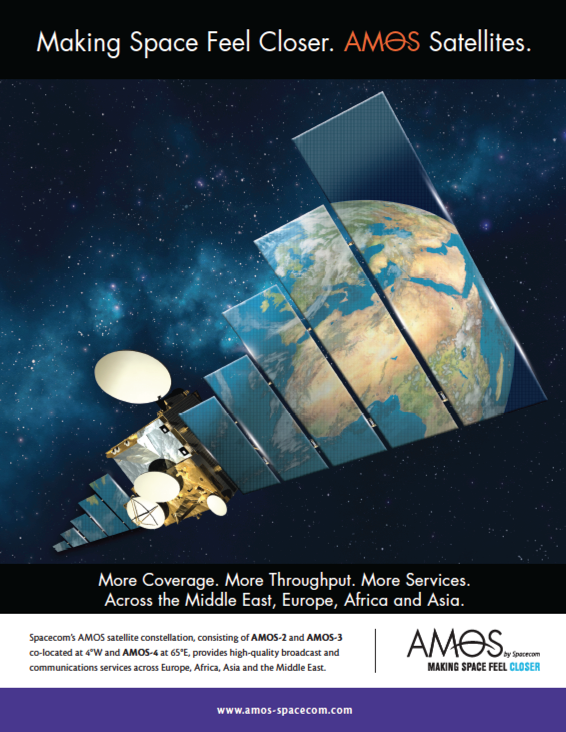Bill Morrow is a turnaround specialist who is well-known with more than 30 years of experience in the telecommunications industry. He has been the CEO of public, private, and government-owned companies and has successfully managed firms across cultural boundaries, having been a CEO in four different countries.
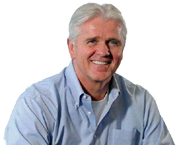
His record of success is backed by results that range from 10 percent CAGR revenue growth to 10 pp market share improvements to a 4x realized improvement in Enterprise Value.
In April of 2014, the Australian Government appointed Bill as Chief Executive Officer of nbn™, the company which is responsible for creating a leading edge, national broadband network for all Australian homes and businesses.
Prior to his present role, he served as Chief Executive Officer of Vodafone Australia. He was appointed in March of 2012 with a remit to turnaround a multi-year performance degradation. After just two years, he achieved that goal, which in turn led the Australian Government to select him for his current role.
Prior to his Vodafone Australia role, Bill served as Chief Executive Officer of Clearwire Corp. from March 2009 to March 2011. From July 2007 to September 2008, Bill performed as President, Chief Executive Officer of Pacific Gas & Electric Co., a public utility company and subsidiary of PG&E Corp., and from August 2006 to June 2007, Bill was that company’s President and Chief Operating Officer.
In 2006, Bill served as Chief Executive Officer of Vodafone’s Europe region through Vodafone Group PLC. From April 2005 to April 2006, Bill’s title was as President of Vodafone KK in Japan. From 2004 to 2005, he was the Chief Executive Officer of Vodafone UK, Ltd. From 2001 to 2004, he served as President of Japan Telecom Holdings Co., Inc., a fixed and mobile communications provider.
Bill holds an A.S. in Electrical Engineering and a B.A. in Business Administration. He presently resides in Sydney Australia and returns to his home town of San Francisco several times a year to visit family and friends.
A Discussion With Bill Morrow of nbn™
SatMagazine (SM)
First, Mr. Morrow, would you tell our readers about your background in communications?
Bill Morrow
I studied electrical engineering before working my way up the ranks to leadership roles for a number of global communications companies such as Vodafone, Clearwire Corp. and Japan Telecom. These experiences have led me to my seventh CEO position, at nbn in Australia.
Technology is at the core of nearly every part of our lives and I love being a part of an industry which is continually evolving and helping us to improve the way we live.
SM
Why did you decide to engage with the Australian government to pursue your career at nbn?
Bill Morrow
I have been involved in many great companies in my career but nothing comes close to this one. As an infrastructure project, the size and scope of the network is unparalleled.
However, it was not simply the ambitious nature of the project that attracted me to the job—it was also the challenge of building the strength of the company to match the might of the project.
Working on this project is a once-in-a-lifetime experience. I believe the nbn™ network will help to ensure no Australian gets left behind. It will mean every Australian child will be able to access educational services online, every Australian entrepreneur will have the opportunity to run their business from wherever they want in the country and of course Aussie parents don’t have to deal with arguments on a Sunday afternoon when everyone wants to get online.
SM
How and why was nbn™ created by the Australian Government, and when did SATCOM become a major component of the company’s business plans?
Bill Morrow
The nbn™ network is the largest infrastructure build in the country, possibly in the world. It’s designed by the Government to provide universal access for all Australians to fast, affordable and reliable Internet and landline phone services as soon, and as cost effectively, as possible.
Broadband is taking its place beside electricity and water: every home and business needs it. That’s why we are building a fast and reliable network as quickly as possible. Communities without access to fast broadband can be left behind and that can hurt families, businesses and the economy.
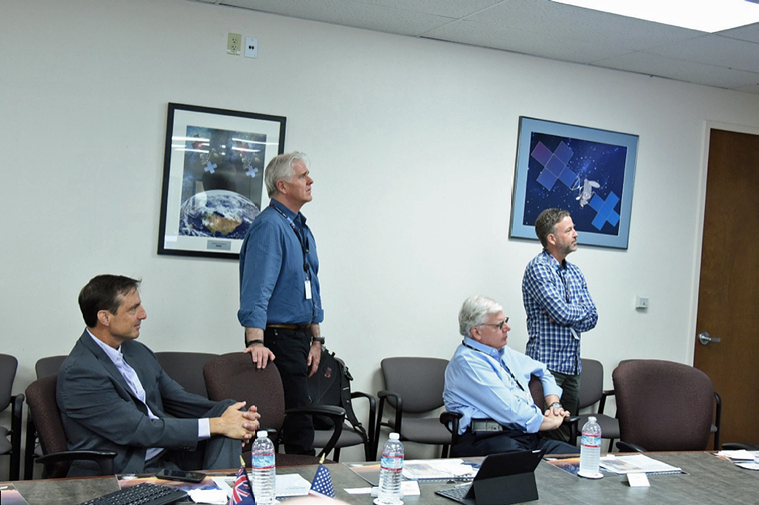
In rapt attention watching the lift-off of Sky Muster II at the SSL Mission Control Center (MCC). Pictured, left to right: Greg Bossert, Sky Muster II Program Manager—Bill Morrow, CEO, nbn—John Celli, President, SSL—Brad Whitcomb, Chief Strategy and Business Transformation Officer, nbn. Photo is courtesy of SSL.
The use of satellite technology has always been part of our plan for the network as it is the quickest and most cost effective way to deliver fast broadband to remote and regional parts of Australia who, for too long, have been left behind.
SM
What have been nbn™’s major business goals under your supervision? How successful has the firm been in meeting the milestones you have established for the firm since your appointment in April of 2014?
Bill Morrow
I’m incredibly proud of the achievements which the nbn team have made over the past few years.
Our team has successfully trialed and deployed a number of new technologies which are helping us to deliver access to fast broadband to Australians right across the country in an unprecedented timeframe using a mix of new and existing infrastructure. Today, there are more than a quarter, or three million homes and businesses, that are able to order an nbn™ service compared with a few hundred thousand only two years ago. We have met or exceeded every target the Board has set for nine consecutive quarters.
Of course, the launch of our two satellites and delivery of their services to Australians who need access to fast broadband the most has been one of the biggest highlights of my time.
The nbn™ network is one of the most complex projects to complete, but I am confident we have the right team to deliver a world-class network for all Australians.
SM
On October 1, 2015, SkyMuster I was launched by Arianespace from French Guiana. Why was this such an historic launch for nbn™? Did the satellite accomplish the communications goals demanded by the company?
Bill Morrow
The launch of Sky Muster™ I was a culmination of many years planning and hard work, allowing us to start delivering quality fast-broadband services to some of the most remotely located areas in Australia, many of these people had very slow or no Internet access at all, so the launch of the satellite was a huge achievement for nbn.
After months of testing Sky Muster™ I, we successfully launched the service in April 2016. Since that date, we have connected more than 36,000 customers, enabling them better access to online education, improved social connectivity, specialist telehealth applications in the home and new opportunities for businesses.
SM
Please explain the technologies that will be at work with SkyMuster II and if there is any differentiation between this satellite and SkyMuster I?
Bill Morrow
Sky Muster™ II is the second satellite to be sent into orbit. Technologically, there is no difference between the two satellites. They are designed to deliver the same service in the same way.
There are more than 400,000 homes within the satellite network footprint and the two Sky Muster satellites will ensure enough capacity to provide good services to the anticipated 240,000 homes and businesses who will likely connect.
SM
If SkyMuster I was so successful, why was there a need for SkyMuster II? What are SkyMuster II’s goals as opposed to those of SkyMuster I?
Bill Morrow
Sky Muster™ II was initially developed to be used as redundancy in case there were any issues with Sky Muster™ I.
After evaluating commercial viability of the satellite rollout and the increased broadband usage in the country, we decided that it made more sense to use Sky Muster™ II to offer increased data capacity to Australian users instead.
SM
Would you tell us about that special competition that revolved around imagery for the nose cone of the launch vehicle?
Bill Morrow
nbn ran a nationwide photo competition to give Aussies the unique opportunity to be included in a mosaic artwork, which was placed on the nose cone of the Sky Muster™ II rocket.
Representing the millions of connections made through the nbn™ network, the winners’ faces make up a national portrait of our country in a mosaic-style artwork, printed on the nosecone of the rocket that launched the Sky Muster™ II satellite into space.
SM
Australia’s satellite history actually started in 1967 with a launch from Woomera, South Australia, in 1967, followed by two Space Shuttle launches of two additional Australian satellites, Aussat A1 and Aussat A2. How important is SATCOM and MILSATCOM to the Australian economy and to the nation’s citizens and why?
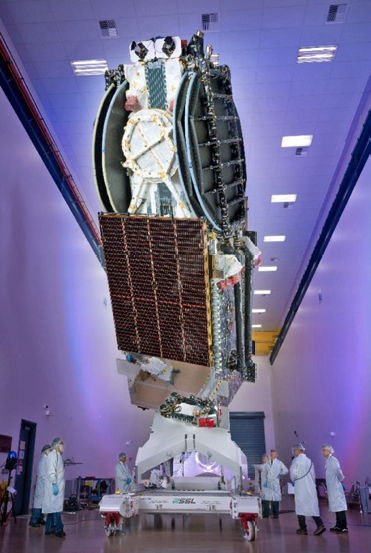
The Sky Muster II satellite in launch configuration at SSL Palo Alto, California, manufacturing facility. Photo is courtesy of SSL.
Bill Morrow
Satellite services play an important role in delivering technology to Australians, especially those located in remote parts of Australia whose access to decent Internet has been limited.
Regional Australia contributes 15 percent of the country’s economy and it is a relatively untapped market in terms of innovation, so the potential is huge with the right tools and support. While city dwellers may take Internet access for granted, there are people across rural and remote Australia who have not previously been able to access quality broadband services, instead experiencing speeds equivalent to dial-up Internet.
Investing in our Sky Muster™ Satellite service is crucial to ensure all Australians have access to fast broadband.
SM
How was Arianespace selected as the launch provider for the SkyMuster II?
Bill Morrow
We were looking to partner with world-class experts to design, build and launch our satellites.
nbn went through a competitive review process and selected Arianespace, one of the world’s leading satellite launch companies with a proven track record of successful launches.
SM
Would you tell us of future nbn™ plans to further support Australians? Will there be a SkyMuster III? Are any additional expansion plans to other areas in APAC under consideration?
Bill Morrow
We have a plan to make fast broadband available to all Australians by 2020.
It is not unforeseeable, but we must closely monitor demand and capacity, before a third satellite, or alternate technology solutions, are considered.
www.nbnco.com.au/
Have you ever wondered how children living in remote Australia complete their schooling when they don’t leave their family behind, traveling far away to attend boarding school? For many, it’s School of the Air.
Queensland’s first School of the Air opened in 1960 in Cloncurry. Today, there are seven schools of distance education operating across the state: Mount Isa, Cairns, Charleville, Capricornia, Longreach, Charters Towers and Brisbane. Road Muster recently dropped in to visit the Mount Isa School of the Air (MISOTA).
MISOTA schools about 180 children from around 120 families, from E-Kindy to year 10, across an 800,000 square kilometer catchment area. If there was ever an example of why the Sky Muster™ service is important, this is it.
Up until the late 90s, School of the Air lessons were conducted via high frequency radio. Despite technological advances, currently at MISOTA children do almost all their lessons over a modified telephone and presentations are of the PowerPoint variety, no skype or video capability.
If there is more than one child in the family, the home tutor needs to juggle the lesson timings to make sure everyone gets a go at using that one phone line to their house. The home tutor is responsible for the daily delivery of the education program, supervision and guidance of students. Lessons and PowerPoint presentations are accessed via an online education portal, which is in the process of moving to a new system, as the current system requires monthly Java updates.
Now, this might not be a big deal to people in the city as it only uses about 50 megabytes for each update, but for remote families the update can take up to an hour, assuming they get no Internet drop-outs.
Can you believe at the moment that children at MISOTA are being taught the violin via the telephone? Kids also have the opportunity to learn a variety of languages, including French, Italian and Japanese. The local Scouts even come in once a week after 3pm to conduct their Scouts of the Air session. Imagine trying to work towards scouting badges via telephone!
The online education component has, until now, had to balance the fact that most families only had access to 20 gigabytes of data per month to run, for example, the farm, the schooling, and any personal online interactions, with download speeds often under 1Mbps.
The school itself was running on a download speed of 3Mbps until about six months ago, when it moved to 10/10Mbps. Despite this, because the lessons are predominantly delivered on audio—the 10/10mbps speeds are just fine for the time being.
Luke and his family live about four hours out of Mount Isa and they have just connected to the Sky Muster™ service. Ben, his son, told me it’s “heaps better” than it was before.*
The Sky Muster™ service has the potential to be a real game changer for many families and will help allow those educating these isolated children to do much more to not only teach them, but draw them together into a school unit. Once more, School of the Air families are on the Sky Muster™ service, MISOTA can move to audio and video online, and with nbn offering up to three additional dedicated 50G education ports per family there should no longer be a need to prioritize lessons based on only having one telephone line.
nbn would like to thank MISOTA for showing us through their amazing facilities and for their commitment to educating remote Queensland children. The nbn™ Sky Muster™ service is helping to change the way regional families can access education. For more information, go to mtisasde.eq.edu.au.
As President of SSL, John Celli is the company’s top executive and is responsible for its strategic direction. He possesses more than 30 years of industry experience and had previously served with the company as Chief Operating Officer, Executive Vice President and Senior Vice President of Engineering, Manufacturing, and
Test Operations.

As Chief Operating Officer, Mr. Celli was responsible for all aspects of operations, and as Executive Vice President, he led the organization responsible for the development, manufacturing, testing and procurement of all satellite units and subsystems—he also oversaw procurement, information systems, and the facilities organization.
From 1996 to 2001, Mr. Celli was executive director of SSL’s Intelsat IX program where he led the successful development and delivery of seven, advanced, multi-frequency communication satellites.
From 1981 to 1996, he held a variety of other engineering and management positions with increasing management responsibility.
Prior to joining SSL in 1981, Mr. Celli held design and management positions for space products and ground systems at Alenia S.P.A. (Rome, Italy) for six years, while supporting academic developments at the Faculty of Engineering, University of Rome.
In 2016, Mr. Celli was honored by the Silicon Valley Engineering Council as an entrant into its Hall of Fame. He was also inducted into the Society of Satellite Professionals International (SSPI) Hall of Fame that
same year.
He is a member of the AIAA and holds a master’s degree in mechanical engineering from the University of Rome, Italy.
A Discussion With John Celli of SSL
SatMagazine (SM)
Thanks for engaging with us, Mr. Celli. First, your background, which covers over 30 years of industry experience… could you share with us as some of your history?
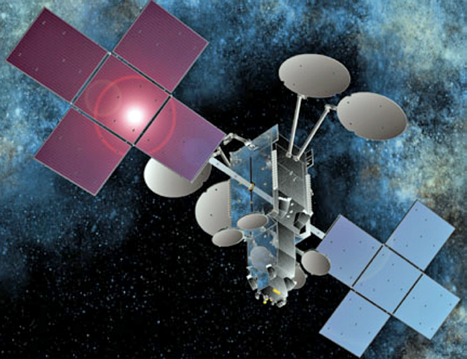
Artistic rendition of the SkyMuster II satellite, courtesy of SSL.
John Celli (JC)
In the summer of 1969, I was a student at the University of Rome, and I needed to decide on my engineering specialty, such as electrical, chemical, or mechanical engineering. In the late hours of July 20, I sat on my balcony overlooking Rome and watched—on a black and white television—Neil Armstrong step onto the moon. At that moment, I heard a roar of cheering coming up from the city below my apartment. It was a powerful moment, an eternal moment, hearing the reactions of hundreds of thousands of people, all responding to this historic space-based event.
Right then, I decided that my engineering specialty would be aerospace. I think many engineers of my generation got into aerospace for the same reason. The satellite industry, then, was a natural fit with my schooling and my interests.
I joined SSL in 1981 and have held a number of different positions, including my role as Director of the Intelsat IX program. This seven satellite program introduced a number of advances and new technologies and was pivotal for both SSL and Intelsat. Then, as Executive Vice President, I was responsible for the development, manufacturing, testing, and procurement of all satellite units and subsystems.
Each position over the years provided me with experience and a thorough understanding of the satellite manufacturing process, as well as the satellite industry as a whole. I had good mentorship at SSL, and as I moved into management roles, I found that I liked the management aspect of the job. I’m not sure anything truly prepares you for this type of role, but the combination of my various experiences at SSL and my passion for aerospace led me to my current position.
SM
What drew you to SSL from Alenia S.P.A.?
JC
At Alenia I was working on components and at SSL, which was called Ford Aerospace at the time, I had the opportunity to work on satellite systems. This was much more interesting work.
SM
SSL has been developing and manufacturing satellites for quite some time… would you tell our readers about some of the milestone missions in this area of SSL’s history?
JC
Our first operational satellite was Courier 1B, launched in 1960. It was the world’s first active repeater satellite and was used to broadcast a message from President Eisenhower to the United Nations.
We have come a long way since that time. We developed the 1300 platform, which is the world’s most popular design for geostationary satellites. It was first launched in 1989 and, last year, we celebrated the 100th satellite based on this continually evolving platform.
Driven by demand from the Direct-To-Home (DTH) television industry for higher power satellites, we were the first satellite manufacturer to develop a 20 kW spacecraft, launching the first one in 2008. Today, there are 13 20 kW class satellites built by SSL on orbit and we have six more in production.
Another milestone for the company was building the world’s first High Throughput Satellite (HTS), which was launched in 2005 for Thaicom’s IPSTAR broadband service. We continue to be a leader in HTS and we built the two highest capacity broadband satellites on orbit today, which both provide service in North America.
However, SSL is about more than just building commercial GEOs. We are building have some extremely innovative LEO satellites for both Earth Observation (EO) and communications in production. We are working with NASA on a program to actually assemble spacecraft on orbit.
Our expertise and skills are applicable to a broad range of space systems including the development of persistent platforms in space and vehicles that will travel to the moon, Mars and beyond. This is a most exciting time for the industry.
SM
Why was the SkyMuster II satellite such an important project for SSL?

Have you ever wondered how children living in remote Australia complete their schooling when they don’t leave their family behind, traveling far away to attend boarding school? For many, it’s School of the Air.
Queensland’s first School of the Air opened in 1960 in Cloncurry. Today, there are seven schools of distance education operating across the state: Mount Isa, Cairns, Charleville, Capricornia, Longreach, Charters Towers and Brisbane. Road Muster recently dropped in to visit the Mount Isa School of the Air (MISOTA).
MISOTA schools about 180 children from around 120 families, from E-Kindy to year 10, across an 800,000 square kilometer catchment area. If there was ever an example of why the Sky Muster™ service is important, this is it.
Up until the late 90s, School of the Air lessons were conducted via high frequency radio. Despite technological advances, currently at MISOTA children do almost all their lessons over a modified telephone and presentations are of the PowerPoint variety, no skype or video capability.
If there is more than one child in the family, the home tutor needs to juggle the lesson timings to make sure everyone gets a go at using that one phone line to their house. The home tutor is responsible for the daily delivery of the education program, supervision and guidance of students. Lessons and PowerPoint presentations are accessed via an online education portal, which is in the process of moving to a new system, as the current system requires monthly Java updates.
JC
Sky Muster II and the first Sky Muster satellite, which was actually our 100th 1300, are sophisticated HTS that bring high speed broadband to people in Australia who cannot be served by cable, fiber or wireless. The satellite was important to SSL because this demonstrates our capability to deliver a complex, high capacity Ka-band satellite.
More important than the technical achievement is knowing that this satellite will improve life for hundreds of thousands of Australians. This is important to us as a company to know that a satellite we built will help children in remote areas have more interactive schooling, that the satellite will save lives through emergency telemedicine, and that SkyMuster II will improve economic opportunity for the many Australians living in the bush. That is most gratifying.
SM
Were there any special areas of development for SkyMuster II during the satellite’s manufacturing process that highlight SSL’s expertise?
JC
There were numerous technology advances on the Sky Muster satellites, many of which were implemented to reduce mass and improve performance.
The satellites use multiple spot beams in an advanced design that optimizes bandwidth for Australia’s widely distributed population. Due to the size of Australia, eight antennas, four of which measure 2.9 meters in diameter, were required.
It was a challenge to position these antenna reflectors so that they did not interfere with the satellite’s four, smaller 1.2 meter reflectors, and so they would fit into the launch vehicle fairing. The smaller antennas shape the large spotbeams that serve the less populated areas and the larger antennas form the powerful small spotbeams that serve regions of Australia just outside major metropolitan areas that are more densely populated.
We had to design and engineer an extra-long boom structure that placed the large reflectors further away from the body of the satellite in order to accommodate all the reflectors.
SSL is a leader in HTS that provide broadband Internet to remote areas. We have built the two highest capacity satellites providing service on orbit today. These are being used for consumer broadband in North America. We also built the world’s first high throughput satellite more than 10 years ago, which is being used by Thaicom to provide the IPSTAR broadband service in Southeast Asia.
SM
Working with international firms with varying time zones and national priorities can be rather daunting… how well did SSL and nbn™ interface throughout this process?
JC
It was a pleasure to work with nbn and our teams became very close. The nbn program manager and her team came and lived in Palo Alto, California, during the most important phases of the program. They worked closely with the SSL engineering team to monitor all the assembly and testing we performed and they were able to respond quickly to issues when decisions had to be made. I think nbn enjoyed SSL’s openness and transparency.
We are most impressed with the capability of the nbn team, which had to build an entire system for high speed broadband connectivity. The satellites are an important part of this amazing system. What they have created is a distinctly impressive achievement. We respect and admire the skill, ingenuity and effort that nbn brought to building out this network.
It’s true that we work with satellite operators all around the globe and sometimes that means not getting as much sleep as we would like—however, the international nature of the satellite industry is something that attracts and inspires many of us. We learn so much by being exposed to different cultures and customs and having the opportunity to travel all over the world.
SM
SSL has worked with Arianespace on many prior launches. Could you tell us about your development work and what decision must be made from the SSL side for a successful launch?
JC
Sky Muster II was our 57th satellite that was launched by the Arianespace team, so we are old friends. Arianespace has an excellent record of successful launches and has the process down to an art.
Their team is extremely well organized and professional. Typically, the SSL team travels with the satellite to the launch base and we oversee all the preparations which include encapsulating the satellite into the launch vehicle fairing and fueling the satellite. We continue monitoring the satellite closely right up until lift-off and then we quickly obtain a signal from the satellite once it separates from the launch vehicle.
SM
There are a number of new technologies coming into play regarding satellite development, such as 3D printing and smallsats. How is SSL accommodating new science and incorporating such into your projects? What new technologies are of most interest to you? Are there smallsat projects in SSL’s future?
JC
We are continually developing new technologies to make spacecraft more flexible, less costly and more reliable. We have used 3D printing for some time and it is enabling us to reduce mass and add more capability in significant ways now.
We began building innovative small LEO satellites for Google’s Terra Bella in 2014 and we have announced a couple of other small satellite programs for both EO and communications. These projects are exciting, both in terms of bus and payload technologies. A different mindset is required to build small LEO satellites as compared to geostationary satellites that are expected to provide service for more than 15 years on orbit. We have a great team of bright, young engineers who continually bring new ideas to the table.
On the communications side, we are focused on smaller satellites, and satellites that offer capacity never dreamed of before. We partner with our customers to bring new capabilities to market and have been working with new spectrum bands, such as Q- and V-band, and laser communications as well as photonics.
On the spacecraft side, we are leaders in solar electric propulsion and are developing increasingly higher power capability. We also provide a new way for small satellites to get to orbit with our PODS technology. This means a
100 kg satellite can hitch a ride with one of our GEOs and then it is released from the satellite in either GEO orbit or GEO transfer orbit.
Through our heritage with MDA, we are the only satellite manufacturer with the ability to build on the robotics technologies proven on the Space Shuttle, the International Space Station, and Mars landers and rovers. We are further developing these technologies for satellite assembly on orbit and technologies and systems for a future ecosystem that will enable deep space exploration, habitats and missions.
SM
How does SSL manage the cost structure and build time expectations that are major concerns for satellite operators?
JC
Lower cost and shorter time to orbit are key issues for our customers and both are a strong focus for our development activities. For us, the biggest game changer in terms of lowering cost comes from standardization and from optimized testing and reporting requirements.
For satellite operators that can work within our standardized parameters, we can deliver spacecraft in less than 24 months. We have delivered several satellites ahead of schedule this year. BRIsat is a good example. The first satellite ever built for a bank was delivered in just 23 months. Intelsat 36, which launched last August, was delivered in just 24 months.
Automating documentation streamlines review processes and satellite operators that embrace advances such as the use of electronic systems to record production quality and optimized testing, also benefit from shorter delivery schedules and reduced cost.
Standardization and mass production is especially significant for large constellations. Frequent launches and replacements reduce the need for stringent testing significantly but the question is whether the cost of launch can be driven down enough for this to be a successful business case.
SM
Is SSL playing a role in assisting with the development of future launch vehicle engine projects?
JC
That is not something we are focused on but we do work closely with launch vehicle providers to optimize compatibility with our spacecraft.
SM
An area of interest to our audience is the training of those who are to become tomorrow’s engineers and technical specialists within the SATCOM and MILSATCOM arenas. How is SSL supporting STEM training at the secondary, high school and college level?
JC
SSL is very active in encouraging children to pursue STEM careers. We have a large team of volunteers who give presentations at local schools and colleges and we collaborate with local non-profit organizations such girlSPARC, LISTAS, Society of Women Engineers (SWE), and Techbridge to bring young people to visit our facility.
Meeting engineers face-to-face and seeing the satellites that we have under construction in our hi-bay really inspires young people. We are also members of Change the Equation, which is a coalition of corporate members leading a movement to ensure that every young person in the US is STEM literate through high-quality STEM experiences that spark a lifelong love of learning.
SM
Are there any special projects or missions that have played a significant role in your career? If so, what might they be?
JC
The Intelsat IX program was one of the highlights of my career. As Program Director I was responsible for building a large number of complex satellites for a very demanding satellite operator. I was responsible for managing European and Japanese suppliers of key subsystems which had to be integrated into our 1300 platform. This was a highly challenging and exciting time in my career.
In the 2005 to 2006 timeframe, we worked diligently to become the world’s leading manufacturer of commercial geostationary satellites. We had to quickly ramp up production and we were extremely gratified with the success that has continued to this day.
However, the thing that has been most satisfying to me over the course of my career is the large portfolio of satisfied satellite operators that rely on SSL for replenishing and growing their fleets. We have so many loyal long-term customers that come back to us repeatedly, and every year we also add new customers who are working with us for the first time and will come back to us in the future.
I have developed so many friendships over the years with the highly competent and hard-working people who are responsible for providing the important services that help make the world a better place.
www.sslmda.com


